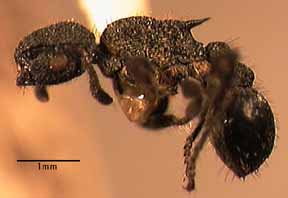

Formicidae, Hymenoptera, Insecta, Arthropoda, Animalia
|
|
|
Image catalogue, lectotype worker (click here).
Range
Colombia.
Diagnosis
See discussion of rudis group. Face sculpture clathrate, composed of polygons delimited by thin walls; increasingly longitudinally oriented medially; striae and polygon walls narrower than intervals or internal diameters of polygons; intervals smooth and shining; frontal carina separated from torulus dorsally, curving mesad and joining lateral carina on clypeus; AT4 coarsely striate over at least anterior half; ASW 0.035-0.037mm (n=2); HW 1.31-1.44mm (n=2).
Additional Description
Clypeus at level of antennal insertions abruptly bent ventrad; clypeus with prominent median longitudinal carina, flanked with 3-4 longitudinal carinae on each side; torulus trough weakly developed; eyes nearly symmetrically convex; vertex margin obtuse, weak, obsolete medially; vertex shiny with coarse, longitudinal, parallel striae; posterior face of forefemur smooth and shining to coarsely striate; mesonotal teeth vary from squared-off right-angle lobes to projecting, subacute teeth; anterolateral propodeal lobes obsolete, or with variably pronounced subtriangular teeth a short distance posterior to anterolateral margin; propodeal suture weakly but distinctly impressed, not breaking sculpture; AT5 smooth to irregularly and faintly punctatorugose; AS4 with about 10 striae anterolaterally, smooth elsewhere; dorsal setae on face, mesosoma, and gaster abundant, stiff, erect; color shining black, with variable amounts of red on legs.
The rudis lectotype and four additional workers from the original syntype series, all from Bogota, are relatively uniform in size and sculptural details, but are variable in propodeal spine orientation and forefemur sculpture. The type has propodeal spines divergent, forefemur smooth, and AT4 coarsely striate over most of surface (ASW 0.035mm), leaving a narrow smooth band posteriorly. Three of the other workers are similar to the lectotype, but one worker has subparallel spines and coarsely striate forefemur.
Five collections from the Cauca Valley in Colombia's Valle and Risaralda departments have HW 1.44mm (n=1); propodeal spines always divergent; forefemur always striate; and AT4 coarsely striate (ASW 0.037mm) over entire surface (4 collections) or fading half way back (1 collection). Also, these collections exhibit a weak torulus trough, approaching mayri in this respect. They are all quite similar to the rudis lectotype.
Lectotype worker measurements: HW 1.32, HL 1.27, SL 0.84, EL 0.37, MeL 1.81, PrW 0.67, PrL 0.41, PrS 0.38, PrT 0.79, MTL 1.00, MFL 1.13, MFW 0.37, PtL 0.51, PtW 0.48, PpW 0.61, PtH 0.41, AL 1.37, AW 1.39, ASW 0.035.
Natural History
This species is known from a few montane sites in Colombia. Nothing is known of its biology, but it is probably similar to laeviventris and mayri.
Types and Synonymy
Cataulacus rudis Mayr 1870:414. Lectotype worker, paralectotype worker: Colombia, Bogota, "S. Fe" (Lindig) [NHMW; examined August 1998].
Procryptocerus rudis: Emery, 1887:470; Kempf 1951:28 (redescription of worker, designation of lectotype).
Material Examined
COLOMBIA: Sante Fe de Bogota, 4¡36'N 74¡5'W (Lindig) [rudis lectotype NHMW]; Risaralda: Santuario, Los Planes, Finca las Delicias [5¡04'N 75¡58'W], 2200m, 14 Sep 1991 (F. Fernandez) LACM ENT 139767, LACM ENT 139768, LACM ENT 139769, LACM ENT 139770, LACM ENT 139771, LACM ENT 139772, LACM ENT 139773, LACM ENT 139774, LACM ENT 139775, LACM ENT 139776 [JTLC, LACM]; Valle: Medio Calima and Rio Bravo [3¡55'N 76¡35'W], 3 Sep 1989 (W. Mackay) LACM ENT 139782 [LACM]; above Lago Calima [3¡54'N 76¡30'W], 1600m, 21 Jun 1971 (W. L. and D. E. Brown) LACM ENT 139871 [MCZC]; Represa Calima below dam [3¡54'N 76¡30'W], 1200m, 21 Mar 1967 (R. B. Root and W.L.Brown) LACM ENT 139868, LACM ENT 139869, LACM ENT 139870 [MCZC]; 6mi W Cali [3¡27'N 76¡40'W], 1630m, 20 Mar 1955 (Schlinger and Ross) LACM ENT 139872 [LACM].
Literature Cited
Emery, C. 1887. Catalogo delle formiche esistenti nelle collezioni del Museo Civico di Genova. Parte terza. Formiche della regione Indo-Malese e dell'Australia. Annali del Museo Civico di Storia Naturale di Giacomo Doria (2)4:209-258, 3 figures, 2 plates; 5:427-473, 2 plates.
Kempf, W. W. 1951. A taxonomic study on the ant tribe Cephalotini (Hymenoptera: Formicidae). Revista de Entomologia 22:1-244.
Mayr, G. 1870. Formicidae novogranadenses. Sitzungsberichte der Akademie der Wissenschaften in Wien 61:370-417.
Page author:
John T. Longino, The Evergreen State College, Olympia WA 98505 USA. longinoj@evergreen.edu
Date of this version: 4 September 1998.